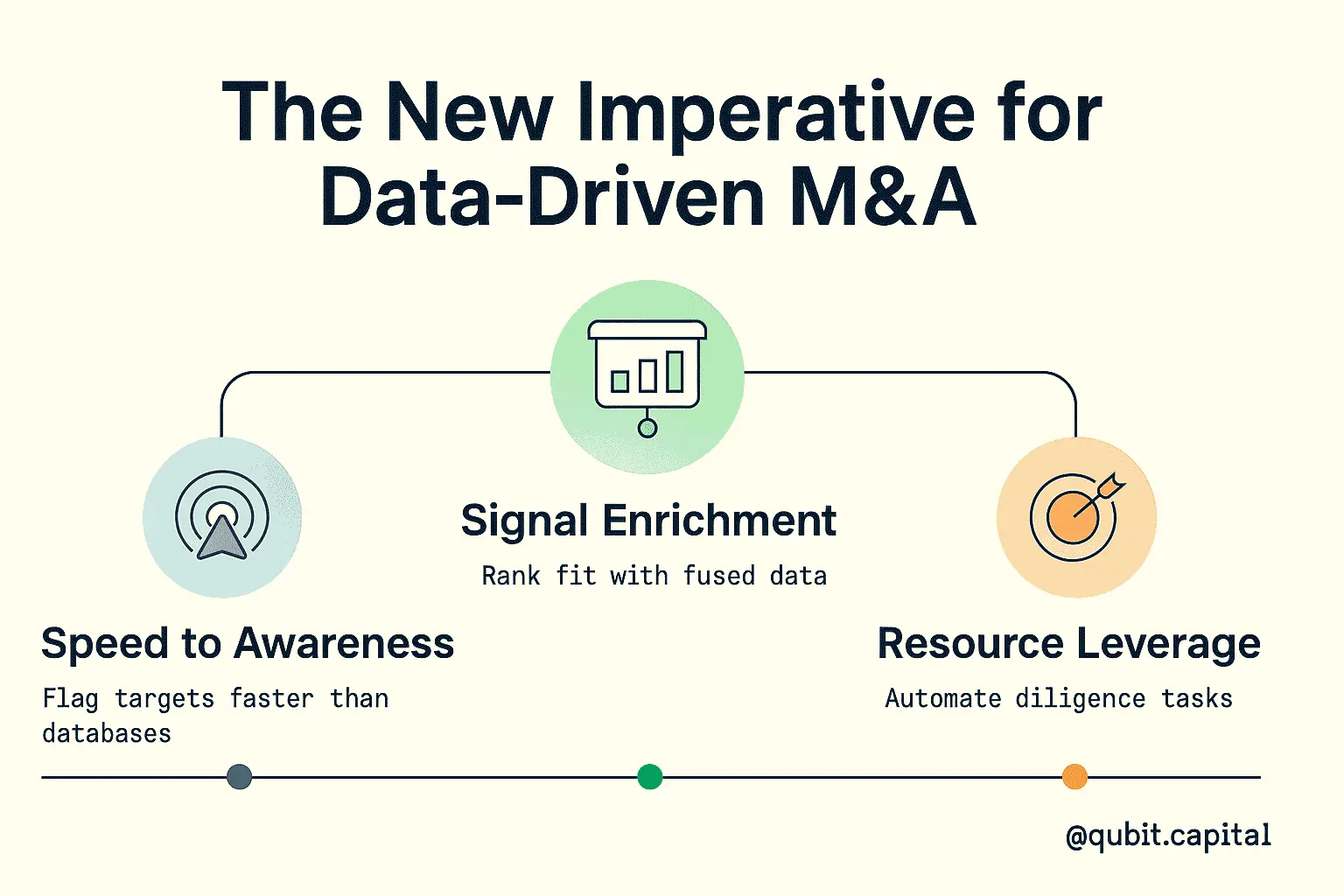The choreography of a modern startup acquisition no longer revolves around banker pitch-books and late-night spreadsheet marathons. A growing stack of artificial-intelligence platforms now surfaces targets months earlier, predicts which bidders will stick around, auto-redacts sensitive material, and flags every out-of-market contract clause before a human reviewer opens the file.
The result is a deal cycle that feels less like a frantic relay race and more like a guided workflow in which algorithms handle the drudgery and people reserve their energy for judgment-calls and relationship building.
This article explores the key AI tools reshaping each step, sourcing, data-room management, legal diligence, and end-to-end orchestration, while addressing the practical limits and emerging ethical questions that accompany them.
The New Imperative for Data-Driven M&A
Competition for attractive acquisition targets has intensified as record amounts of dry powder chase a shrinking pool of venture-backed assets. Simultaneously, large strategics are under pressure to buy innovation rather than build it. Against that backdrop, AI platforms promise three advantages.

- Speed to awareness: web-scraping and NLP pipelines flag newly incorporated companies or niche bootstrapped players long before traditional databases ingest them.
- Signal enrichment: machine-learning models fuse public and proprietary data, ranking targets by strategic fit and likelihood to transact.
- Resource leverage: document-intensive diligence tasks once monopolized by junior talent are completed in minutes by clause-extraction engines, freeing experts for higher-order analysis.
AI Deal-Sourcing Engines
1. Harmonic.ai Tracks the Business Internet in Near Real Time
Harmonic scrapes incorporation registries, job boards, personal LinkedIn updates, domain registrations, and SEC filings to maintain profiles on more than thirty million companies, refreshing key attributes daily. Investors receive alerts when a stealth venture hires its first engineer or a dormant entity suddenly registers a trademark, creating a first-mover edge that conventional pitch-books cannot match.
2. Grata Uses NLP to Reveal Non-Obvious Middle-Market Gems
Grata’s engine reads entire corporate websites and applies semantic search to identify “hidden champions” that sit outside the venture bubble. The platform’s coverage, over nineteen million private companies, includes firmographic data, executive contacts, and transaction histories often missing from legacy datasets. Proprietary AI classifies industries, revenue ranges, and ownership structures, then recommends look-alike targets based on a buyer’s past acquisitions.
3. Datasite Marries Redaction AI With Predictive Checklists
Datasite’s Redaction AI reads uploaded documents, locates personally identifiable information, and proposes bulk redactions that reviewers approve with a keystroke, cutting hours from privacy compliance workflows. Its 2025 acquisition of Blueflame added an agentic layer that drafts diligence checklists, assigns tasks, and generates red-flag memos inside the VDR environment.
Every reviewer action trains the model to improve its topic suggestions and risk scoring on future deals, converting a formerly passive vault into a learning system.
4. Ansarada Scores Bidder Intent Through Behavioral Analytics
Ansarada’s platform captures fifty-plus engagement metrics, scroll depth, repeat visits, Q&A velocity, and feeds them into a machine-learning model that predicts which bidders are likely to drop out, with ninety-seven percent accuracy by the first week of activity. Sellers can redirect resources toward serious acquirers and nudge laggards before momentum stalls, compressing timelines without sacrificing competitive tension.
5. Kira Systems Extracts Clause-Level Intelligence at Scale
Now part of Litera, Kira employs lawyer-trained models to identify more than 1,400 clause types across forty practice areas, delivering up to an eighty-percent reduction in manual review time. A conversational interface answers prompts such as “show change-of-control terms that deviate from market” and links each result to its source paragraph for rapid partner verification.
6. Luminance Delivers Multilingual, Conceptual Understanding
Luminance pairs supervised and unsupervised learning to build a conceptual map of every uploaded document, highlighting anomalies against a user-defined model agreement. The system parses contracts in more than eighty languages, clusters similar clauses for batch review, and flags deviations that may expose post-acquisition liabilities. Deployments report review cycles shrinking from two months to two weeks and outside-counsel spend falling seventy-five percent.
Orchestrating the End-to-End Deal Execution
A Control-Tower Approach
Best-practice workflows stitch these point solutions into a closed loop. A simplified sequence might look like this—without relying on the forbidden numerical prefixes:
- Harmonic alerts identify a newly incorporated AI cybersecurity startup that matches a buyer’s thesis.
- Grata’s semantic engine surfaces additional look-alike companies and their executives.
- Qubit Capital’s orchestration layer scores each prospect, suggests a warm introduction path, and launches a tailored outreach sequence referencing the target’s latest patent filing.
- After a non-disclosure agreement is signed, Datasite opens a VDR; Redaction AI auto-scrubs sensitive data, while Blueflame drafts diligence checklists.
- Kira extracts red-flag clauses from legacy customer contracts; Luminance performs a multilingual compliance sweep.
- Ansarada’s bidder-engagement AI monitors activity, signaling when to escalate negotiations or walk away.
Firms running such an integrated stack report thirty- to forty-percent faster time-to-term-sheet and materially lower legal-review costs, according to vendor case studies and user surveys.
Qubit Capital as the Learning Brain
Qubit’s advantage is a feedback mechanism that records every pass, progression, and closed deal, then retrains its scoring model so “ideal target” definitions evolve alongside the investor’s strategy. Corporate acquirers add governance tags that route opportunities to the correct business unit and track post-close integration milestones, maintaining deal context long after the purchase agreement is signed.
Pipeline Integration and Prioritization Workflows
Sourcing tools on their own do not close deals. Their real value emerges when alerts pipe into a centralized CRM that scores targets against a live investment thesis and triggers personalized outreach sequences. Qubit Capital, for example, ingests API feeds from Harmonic or CSV exports from Grata and re-ranks prospects using a fund-specific weighting of sector adjacency, ticket size, and geographic mandate. Analysts see a “next best action” for every deal, from who can provide a warm intro to which product milestone to reference in the first email, turning raw signal into structured motion.
Risks, Limitations and Ethical Guardrails
AI adoption introduces new exposures. Over-reliance on algorithmic scores can reinforce historical biases if women- or minority-led startups have thinner digital footprints. Proprietary VDR analytics could raise antitrust concerns if bidders gain insight into rival behavior.
Firms must validate model outputs, recalibrate thresholds, and maintain human oversight. Moreover, acquirers must respect target privacy when scraping web data or merging email-derived relationship graphs into sourcing engines.
The Road Ahead: Synthetic Diligence and Autonomous Negotiation
Research labs are training language models on anonymized deal documents to simulate “synthetic due diligence,” where an agent role-plays as buyer counsel and probes for liabilities before any files change hands.
Early prototypes draft entire purchase agreements and negotiate risk-allocation provisions, escalating only unresolved issues to human attorneys. Meanwhile, predictive-maintenance algorithms applied to software codebases hint at future integration assessments that forecast technical debt pre-close.
Conclusion
Artificial intelligence has moved from edge experiment to core infrastructure in mergers and acquisitions. Tools like Harmonic and Grata accelerate discovery; Datasite and Ansarada convert data-rooms into predictive dashboards; Kira and Luminance slash legal review time; and orchestration layers such as Qubit Capital tie the whole flow into a responsive, learning system.
Firms that master both the art of relationship building and the science of algorithmic insight are already outpacing peers who still rely on manual processes. In the next market cycle, the question will not be whether to use AI in acquisitions but how quickly a deal team can deploy, integrate, and continuously refine these intelligent platforms to stay ahead of the competition.
If you're seeking tailored solutions to identify and connect with the ideal acquirers or startups, we invite you to explore our Investor Discovery and Mapping service. At Qubit Capital, we’re committed to helping you achieve impactful acquisition outcomes.
Key Takeaways
- AI tools can significantly streamline startup acquisition processes and M&A strategies.
- Adopting a hedge fund manager mindset when vetting AI tools minimizes risk.
- Pilot projects and employee feedback are crucial for successful AI integration.
- Big Tech’s innovative acquisition tactics highlight the growing value of specialized AI talent.
- Real-world case studies provide actionable insights for leveraging AI in acquisition and operational improvement.
Frequently asked Questions
What are the best AI tools for startups?
Some of the top AI tools include pilot-tested platforms that streamline processes from due diligence to operational automation, making them ideal for startups seeking efficiency.






